The architectural historian in me is fascinated by the threads of science, theory, and symbolism that go into designing and building schools. Like most preservationists, I am a strong believer that the power of place plays a central role in shaping our experiences, attitudes, and values. The tangible aspects of a school’s ‘power of place’ include its architectural style, materials, dimensions, and floor plan. Taken together, these character-defining features often reflect a community’s wealth, prominence, and aspirations for their children. In Philadelphia, schools from the mid-19th century to pre-World War II period fit into this category, regardless of their location in large or small, rich or poor neighborhoods. After World War II, the character of many of Philadelphia’s public schools shifted, and the school buildings communicate a rigid, institutional personality that is markedly different from the schools only a few decades older.
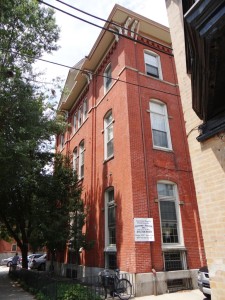
The 1865 Samuel J. Randall Public School at 915 Bainbridge Street is one of Philadelphia’s oldest surviving school buildings, and one with a very rich history.
I set out to write about the many types of architectural styles represented by the City’s public schools I saw in the Philadelphia Public School Survey. As I re-read through the 1986 and 1988 thematic National Register nominations that document public schools built through 1937 and perused my own photos from our reconnaissance survey, I realized that yes, I could stick with that topic, but it kind of missed a big point about historic school buildings. This building type is truly the epitome of the ‘form follows function’ concept espoused by Louis Sullivan and others at the turn of the 20th century. There is no doubt that the exterior appearance is cool and significant and important – those of us versed in the basics of architectural history know that architects and builders used architectural styles to create associations between their buildings and buildings that embodied values akin to the building’s purpose or owner’s goals: think Greek Revival style for government buildings in Colonial America based on the ancient democratic buildings in Greece or Rome, or Gothic style for local primary or secondary schools based on the ivy-covered Gothic Style cathedrals of learning at places like Oxford and Harvard. It seems as if the school’s outward appearance was secondary to their floor plans, with architects utilizing a range of popular architectural styles of the day and that were appropriate for the size of the school and the neighborhood.
I have to admit that my original version of this post was much too long because I found myself wanting to share quite a few interesting facts about Philadelphia’s schools. As an alternative to serious re-writing, I opted to break this post into a few parts so I don’t have to gloss over too much. In this post I’ll talk a bit about the early history and architecture of Philadelphia’s schools through about 1867, when the city’s Superintendent of Buildings position was created. Only seven of these schools survive and were captured as part of the survey, and represent important milestones in school design in Philadelphia. Look for more posts about school design through the turn of the 20th century (we have about thirty-two surviving schools through 1904) and the two periods after that: 1905 to 1937, which accounts for a whopping 47% of the public school inventory and the period after World War II, about 1948 through the end of the 1970s, which represents about 39% of the inventory. I should note for the record, that, unfortunately I didn’t have the chance to get inside these great buildings (such frustration!) and am relying on the 1980s nominations and my trusty internet search engine to help me out.
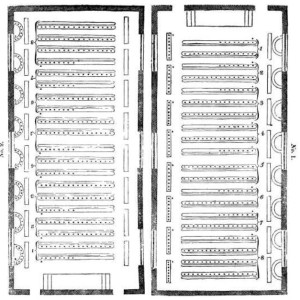
The Lancastrian Plan as drawn in Joseph Lancaster’s 1810 book about this school building and teaching theories. While we don’t know what the original plans of the two schools in our survey, they were likely based on this type of plan. The head of the school is seated at the end of the plan, and the dots represent the monitor that work with groups of students. Source: http://www.constitution.org/lanc/epitome.htm
The Lancastrian Plan
Philadelphia’s earliest public schools, from about 1818 to 1850, were part of a decentralized school system that covered seven sections of the city, and each section was administered by local Boards of Education that reported to one central overseeing body. These schools were similar to the traditional one-room schoolhouse type of buildings with vernacular, utilitarian exteriors that we associate with early primary-level education. What I didn’t know about these early schools is that many, particularly in more urban communities, are based on what is called the Lancastrian Plan. It was developed in England at the end of the 18th century and showed up in the United States in 1806 with a new school building in New York City. Interestingly, two British men claim credit for the system, Dr. Andrew Bell (whose ideas actually came out of an experiment on education in an Indian orphan’s asylum) and a young teacher, Joseph Lancaster. The concept for this plan revolved around having one large open room per floor that contained several classes that could be taught by one principal instructor with the help of monitors, or aides.
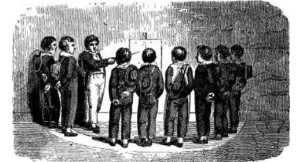
This image, also from Lancaster’s 1810 book, paints an idyllic picture of the Lancastrian Monitorial System of Education. Source: http://www.constitution.org/lanc/epitome.htm
Lancaster didn’t only develop and promote a floor plan that responded to what he considered the way children learn; he also wrote several treatises on the best way to teach reading, writing, spelling, and math, which is called “The Lancastrian Monitorial System of Education.” Some of his works are available online through sites like the Lancastrian Society.
The Lancastrian Plan shows up in Philadelphia in 1818, and is used as the template for school construction through about 1850; the Plan was so successful that it was quickly adopted by other cities throughout Pennsylvania such as Lancaster, Columbia, Harrisburg, Erie, and Greencastle, among others. These schools were typically long rectangular buildings, with a main entrance in a street-facing gable end, and tended to be built of brick. According to the authors of the 1980s thematic studies, these schools didn’t have much in the way of exterior adornment and most fit squarely in the vernacular “No Style” category.
There are only two schools left from this era built with the Lancastrian Plan with little or no exterior ornamentation, and unfortunately both have been greatly altered: the 1825 Mifflin School on North 3rd Street and the 1850 J. Sylvester Ramsey Public School next to Kahn Park in Center City (1119 Pine St.).
A third building, the Bridesburg Public School (also known as the Irving School) was built in 1847 with some Greek Revival massing and ornament but it is unclear if it was based on the Lancastrian concept.
- The Thomas Mifflin School, 808 N. 3rd St., was built in 1825 and is one of the earliest surviving school buildings in the city.
- The Bridesburg Public School, 2620 Hayworth St., built in 1847, still retains its character-defining form, roof shape, and fenestration pattern.
Samuel Sloan and the Philadelphia Plan
The next period of school building in Philadelphia was again driven by architects and Boards of Education concerned about creating buildings that are specifically suited to changes in pedagogy (the SAT-level word for teaching) and student learning. Between 1851 and 1904, the Philadelphia school system remained decentralized but moved toward a comprehensive building program, particularly with the creation of Samuel Sloan’s ‘Philadelphia Plan’ and the establishment of the Office of the Superintendent of Buildings in 1867. The Controllers of the Public Schools of Philadelphia hired Sloan in 1851 to survey their school buildings and find ways to improve lighting, heating, and ventilation and the way space within the school is organized, which was particularly important as Philadelphia’s growing populations and neighborhoods required bigger and better school buildings. According the Philadelphia Architects and Buildings website, Sloan (1815-1884) was a carpenter when he arrived in Philadelphia in the 1830s, and around 1851 started to promote himself as an architect, right about the time the city’s educational leaders were looking for some professional assistance with their physical plant. His career skyrocketed in the 1850s with many school commissions but fell off sharply after the Panic of 1857 and the Civil War.
Sloan’s design for how school buildings in Philadelphia could be improved earned the nickname, ‘Philadelphia Plan.’ This plan called for a single large room on each of the school’s floors (usually two or three, if the school had a raised basement) that could be separated into separate classrooms by moveable partitions; the flexibility of this program allowed students to gather into one large auditorium-like space when needed yet maintain a certain degree of privacy with less distraction for classroom instruction.
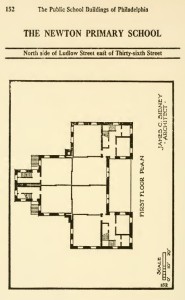
The Newton Primary School, built 1866-1867 by James Sidney, used the ‘Philadelphia Plan’; the slightly skewed lines represent the movable partitions. The school was located north of Ludlow Street and east of 36th Street , now the site of the 36th Street Trolley Portal. This plan is from a 1917 book, Public School Buildings of the City of Philadelphia from 1853 to 1867 available via archive.org.
The classrooms opened directly to staircases and exterior entrances on each side of the building. The plan resulted in wide, rather short, rectangular buildings. Sloan also added closets into the school building to cut down on clutter, a feature which still figures prominently in school design today. Sloan’s plan also placed larger windows to catch the best light and air, thereby improving the light and ventilation throughout the building.
During his heyday, Sloan was responsible for approximately 25 public school buildings between 1851 and about 1856, when school construction in the city was virtually suspended. Like Lancaster’s Sloan’s plan also went far beyond Philadelphia because of its success in practice and its promotion in period books about school architecture and design; according to the authors of the 1980s thematic nominations, schools built on the ‘Philadelphia Plan’ could be found throughout the Commonwealth, except, oddly, in Pittsburgh. Only two of Sloan’s schools are included in the Philadelphia school inventory, the 1851 Watson School on League Street and the 1855 Fayette School, now the Politz Hebrew Academy, on Old Bustleton Ave.
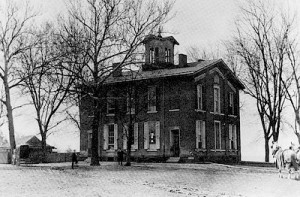
Sloan’s used his ‘Philadelphia Plan’ for the Fayette School, built in 1855. This picture shows the school in the late 19th century before the large 1915 addition by the school district. Source: http://hiddencityphila.org/2012/08/its-been-a-bad-year-for-you-samuel-sloan/
Both of these buildings fall into the general ‘No Style’ category, and may have originally included some Greek Revival features like their predecessors. Unfortunately, neither school survives in its original form, and it was sometimes tough to identify in the field because of later changes. Nonetheless, I include them here because they are an important link in the Philadelphia school building story.
After the Civil War, when construction resumed, the ‘Philadelphia Plan’ continued to be used by later designers until the early 1880s. Local architect James C. Sidney (1819-1881) was a British born cartographer who arrived in Philadelphia in the 1840s. As an architect, engineer, and surveyor, Sidney worked with a number of notable Philadelphia architects like James P.W. Neff and Andrew Adams, which whom Sidney developed the 1859 master plan for Fairmount Park. Sidney is credited with approximately 19 school commissions for the Controllers from the mid-1860s through the 1870s. Sidney used Sloan’s ‘Philadelphia Plan’ but shook things up a bit by using distinct architectural styles – the Italianate or Romanesque – and departing from the traditional brick construction with cut stone walls. Unfortunately none of his schools survive.
I’ve only touched on some of the neat history associated with these school buildings, but I promise the next post about school design and appearance will have more to offer in terms of living and breathing examples of beautiful schools that you can see. We’ll see how the ‘Philadelphia Plan’ continued to inform school design into the early twentieth century until about 1905, when Philadelphia adopted William Wirt’s, a school building superintendent from Gary, Indiana, principles of school construction.
Comment Policy
PHMC welcomes and encourages topic-related comments on this blog. PHMC reserves the right to remove comments that in PHMC’s discretion do not follow participation guidelines.
Commenters and Comments shall be related to the blog post topic and respectful of others who use this site.
Commenters and Comments shall not: use language that is offensive, inflammatory or provocative (this includes, but is not limited to, using profanity, obscene, or vulgar comments); disparage other commenters or people; condone illegal activity; identify the location of known or suspected archeological sites; post personal information in comments such as addresses, phone numbers, e-mail addresses or other contact details, which may relate to you or other individuals; impersonate or falsely claim to represent a person or an organization; make any commercial endorsement or promotion of any product, service or publication.
If you would like to comment on other topics not related to this blog post but related to PHMC, please fill out the PHMC Contact Us Form.
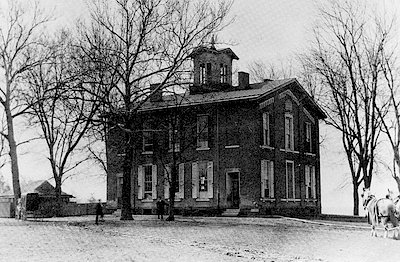
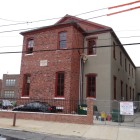
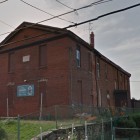
Shelby: would you be interested in turning this into a talk for the Phila Chapter SAH? if so, please email us at info@philachaptersah.org
What an interesting and informative article! Can’t wait for the next installment.
As a co- historian in training at a small town museum, I find this article fascinating. I am studying the architecture of our town’s buildings and although the old schools have been torn down, through the pictures and prints we have, I am seeing a correlation of style. Thank you for this source of information and I too look forward to the next installment.